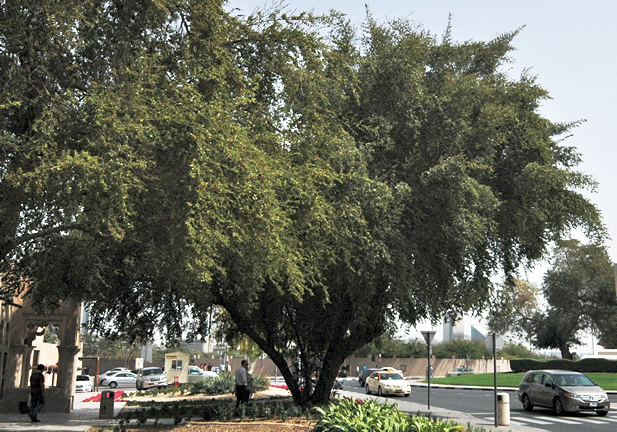| General Description | A Large shrub or small tree with dark green foliage and spines on the stems and suckers. It has yellow flowers that smell like grape soda and date-like green, fruit. |
| ID Characteristic | Reddish prune-like fruit, dark green foliage, little yellowish flowers and spines all over the stem. |
| Shape | Round oval crown. |
| Landscape | Typically used is xeriscape plantings where soil moisture may be at a premium. It has limited ornamental value, the exception being hot, dry environments where any form of vegetation may be appreciated. It is primarily grown for its fruit. It was once classified as a Rhamnus and has many of the characteristics of this often weedy somewhat problematic species. |
| Propagation | Propagation of Ziziphus is commonly performed by seed; place seed in an 18% salt solution and discard all that float. The stones that sink are dipped in 500 ppm thiourea for 4 hours. The seed is removed and sown and will germinate in about 7-10 days, the seed maintains viability for 2-3 years but with decreasing germination rates. T budding or grafting on wild rootstock is the accepted method of propagation. Old trees may be top-worked with more desirable cultivars and there has been some success with air layering. It is reported that limited success has been obtained both with soft and hardwood cuttings. Tissue culture is currently being used where a particular fruit bearing cultivar is required. |
| Cultivation | Grows well in full sun and slightly alkaline or acidic but well-drained soil. It can tolerate drought-like conditions for a period of time and will grow in sand, silt or clay but fails if planted in heavy clay or swampy soils: positive drainage is a must in its culture. It is adaptable to a broad range of climatic conditions from the desert, mountain desert and temperate conditions with temperatures as low as -15 °C; it is the hardiest of the five species. The plant may send up suckers, often at several meters from the trunk and these may need to need to be controlled by pruning or in orchard situations mowing. Irrigation is said to enhance fruit production but is not essential. Pruning to enhance fruit collection maybe beneficial however it does not increase production. A balanced fertilizer such as 10-10-10 may also prove mildly beneficial but not necessary.
|
| Pests | There are at present no reported diseases or major pest problems in the United States however witches broom has been reported both in China and Korea.
|
| Notable Specimens | Many mature trees are found growing in the old quarter of Dubai in the United Arab Emirates. |
| Habitat | It has a confusing geographic distribution due to its long history of cultivation predating early plant classification and collecting expeditions. It is found in southern Asia, between Lebanon, Iran, and further to the north into Pakistan, India, and Bangladesh and Nepal southeast to the Korean peninsula, and through southern and central China at elevations of 1650 m. It is also found in southeastern Europe principally around the Mediterranean region however it is believed that it was most likely introduced there. It was thought to be introduced into cultivation in North America in 1837. In 1908 the United States Department of Agriculture began introducing improved cultivars with an eye towards commercial production. |
| Bark/Stem Description | As the plant matures the smooth bark turns into brown blocky, persimmon-like bark. The branches can be quite thorny (thorns hooked or straight) and the wood very hard. |
| Flower/Leaf Bud Description | Narrowly conical, looks very much like the spines on the stem.
|
| Leaf Description | The lustrous, glabrous, dark green leaves are alternate, simple and oval to ovate-lanceolate in shape. They are 2.5 - 7 cm long and 1-3 cm wide with acute or obtuse base and oblique apices. Leaves are 3 veined at the base with crenate-serrulate leaf margins. The leaf petiole is 3-6 mm in length. There is usually an intense autumn colour of a light, clear yellow.
|
| Flower Description | The, 5-merous, white to green flowers are perfect, to 5 mm across, ovary sunk in disc, usually 2 locular and are held in cymes of 2-3 in the leaf axils of the current seasons growth but are not particularly showy. They are slightly fragrant and are purported to smell like 'grape soda'. The plant may flower over several months but the flowers are only receptive to pollen for one day. Current literature indicates that cross-pollination is not required for fruit set with pollination vectors being both wind and or insects.
|
| Fruit Description | The edible fruit is slender to narrowly conical or ellipsoid, fleshy unwinged, drupe, which matures from July to November. The mesocarp is fleshy while the endocarp is bony. The fruit ripens from green to a dark reddish brown to even becoming slightly dried and wrinkled on the plant and is said to taste similar to an apple. The drupe is 1.2 cm - 2.5 cm long and very similar in shape to plums and is high in vitamin C. The fruit contains a single stone, with a solitary seed. It may produce such a quantity of fruit that they can be a litter problem if planted near high traffic areas. |
| Colour Description | Lush dark green colour during growing season and bright yellow autumn colour. |
| Texture Description | Fine. |


